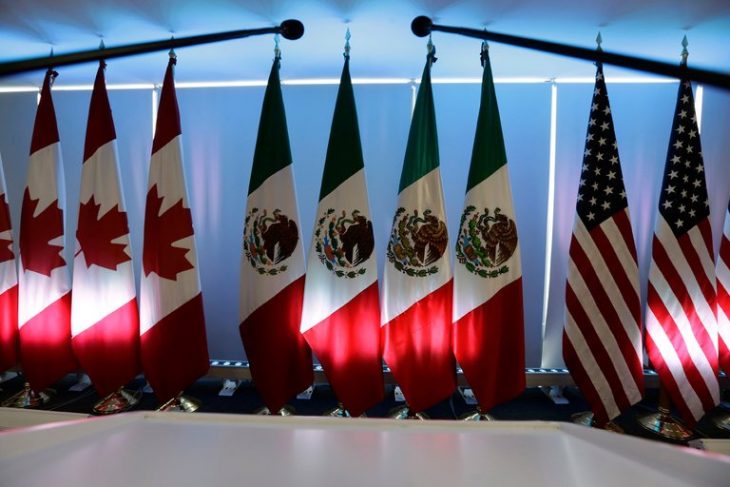- President Donald Trump is not likely to have a new trade agreement when he meets with his Mexican and Canadian counterparts later this week, but there could be one coming in the next several weeks.
- Trump is motivated to show progress in the talks to renegotiate the North American Free Trade Agreement as a signal to farmers and others hurt by his trade skirmish with China that he does care about trade agreements.
- A NAFTA deal would be a “win-win” for Trump. It would give him both a new accord to appease Midwest manufacturing states because of changes in auto content and the retention of the NAFTA rules that have favored farmers in the pro-Trump farm belt.
President Donald Trump and his Mexican and Canadian counterparts are likely to publicly tout signs of progress in renegotiating NAFTA when they meet in Peru on Friday, even if the hard details are not resolved.
Analysts say the anticipated nod of endorsement from the three leaders at the Summit of the Americas will be a likely prelude to a renegotiated North American Free Trade Agreement in coming weeks.
Negotiations between the three countries, previously mired by unpalatable U.S. demands, have made progress just as Trump’s rhetoric against China’s trade policies increased. Trump last week threatened tariffs on another $100 billion in Chinese goods after China retaliated with threats of its own tariffs on American agricultural and other products. That was in response to the Trump administration’s earlier proposed $50 billion in tariffs on Chinese goods.
As for North American trade, there has been an effort to reach an agreement in principle this month as election activity in Mexico ramps up ahead of a July 1 vote. There even appears to be progress on the thorniest issue — the U.S. demand for more NAFTA and U.S. components in automobiles.
“From a policy point of view, they all have an incentive to make this work. The Republicans need to demonstrate to the agricultural places in this country that are going to be important for the House and Senate races that trade policy is not going to just be hurting them,” said Tom Block, Fundstrat Washington policy advisor.
Block notes that the farm states, which would be hurt by proposed Chinese tariffs on grains, are all Republican strongholds that had voted for Trump.
“I think that they’re looking for a way of demonstrating that they’re going … to be tough on China but show they have an ability to walk and chew gum at the same time and they can be more accommodating toward NAFTA,” said Block. “I think that’s going to send a signal to the agricultural and business communities that ‘we’re going to be smart about this and not just blindly anti-trade.'”

Non-GMO corn is harvested with a John Deere & Co. 9670 STS combine harvester in this aerial photograph taken above Malden, Illinois
Trump said Monday there was progress on NAFTA, and he repeated his threat to end the deal if the U.S. does not get a favorable agreement. He also commented directly on farmers, saying if China hits farmers because they think it hurts him, the administration will make it up to the farmers, suggesting some form of aid or subsidy.
“We’re fairly close on NAFTA, and if we don’t make the right deal, we’ll terminate NAFTA and make the right deal after that,” he told the media after a cabinet meeting. “We have a chance to make a deal on NAFTA.”
Trump’s economic team over the weekend emphasized the potential for negotiating trade concessions with China after the violent stock market reaction Friday to the president’s threat.
Success with NAFTA would help show flexibility.
“There are still issues to be resolved and the U.S. will not get everything Trump wants on issues such as a dispute resolution mechanism and agribusiness subsidies, but sources continue to believe that an agreement in principle could be unveiled in the next few weeks, especially since all sides apparently have agreed on auto content rules,” notes Greg Valliere, chief global analyst at Horizon Investments.
The Trump administration may also be concerned more broadly about what could happen to business activity if the U.S. appears protectionist and inflexible. “I think they’re starting to understand how you negotiate these deals has an effect on your economy,” said Juan Carlos Hartasánchez, a senior director of Albright Stonebridge Group.
On Monday, Mexico’s economy minister, Ildefonso Guajardo, said in a television interview that he sees an 80 percent chance for a new deal by the first week of May.
White House economic advisor Larry Kudlow on Monday told CNBCthat talks are moving forward and “good progress is being made.” He noted that Trump exempted both Canada and Mexico from aluminum and steel tariffs, pending a successful reworking of NAFTA.
Valliere said even rough outlines of a deal would be encouraging for the markets.
“Many Republican lawmakers fear the electoral implications of a China dispute in the U.S. farm belt, and supply-siders — including Larry Kudlow — fear the dollar amount of potential tariffs could negate some of the impact of tax cuts, even though the overall GDP impact of the trade dispute still looks modest — for now,” Valliere said.
Analysts say Canada and Mexico may have more leverage in the negotiations now that the U.S. has become more interested in a deal.
“It’s become a win-win for Trump. He has a double consideration,” said Carlos Peterson, Mexico analyst at Eurasia Group. “He has the Midwest manufacturing states that want to see NAFTA change, and he has the traditional Republican states [in the farm belt] that want to see him preserve most of NAFTA and what has benefited most of these other states.”
Peterson said the talks between the negotiators are now very technical. While there has been more agreement on auto content, he said there is not total agreement. For instance, Mexico is unlikely to give in to a U.S. demand that automotive salaries be raised to $15 an hour for workers in the auto sector.
The U.S. has sought 85 percent NAFTA content in all vehicles and 50 percent U.S. content. Peterson said components are being grouped in five categories and some components will receive stricter content requirements than others.
Canada has also pushed for dispute resolution to remain as something arbitrated among the three NAFTA members, instead of having complaints go to local courts, as the U.S. demands.
Source: CNBC



